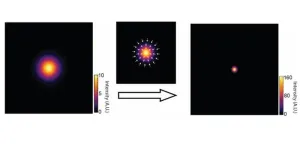(Press-News.org) Recent preclinical results indicate novel next-generation vaccine candidates developed at Cleveland Clinic protect against multiple strains of influenza and last longer than vaccines currently in use.
The vaccines are part of Cleveland Clinic's global vaccine research program, led by Ted Ross, PhD, Global Director of Vaccine Development at Cleveland Clinic. Published in Scientific Reports, the study credits the preclinical success of the influenza B vaccines to novel technology called Computationally Optimized Broadly Reactive Antigens (COBRAs).
Current vaccines use small, non-infectious parts of the virus or bacterium called antigens to train the immune system against infection. Keeping that immunity current can require yearly updates as the pathogen mutates, like for the flu vaccine. COBRAs are antigens designed to train the immune system's response more broadly to anticipate any changes.
"Seasonal influenza vaccines are mostly effective against pathogens with antigens matching the vaccine formulation," says study first author Michael Carlock, program manager in Dr. Ross's lab and PhD student at the University of Georgia. "Viruses like to mutate constantly. If their antigens change too much, our immune system won't recognize them as the pathogen that the vaccine trained them to fight. We constantly need to update our vaccines to keep up with these new variants and mutations."
Further complicating the issue, a strain can mutate into multiple variants, and multiple strains of the same virus can break out at the same time. Vaccines made using an antigen specific to one strain or variant aren't always as effective against another.
Vaccine developers currently use a combination of statistics and public health data to predict what flu strains will be the most common that year. They use antigens from those strains to make their vaccines. However, often by the time vaccines are manufactured and distributed, strains can mutate and render the vaccines less effective, Carlock says.
"Between 2001 and 2012, the influenza B strain used to make the flu shot matched the main influenza B strain infecting the population about 50% of the time," he says, "The vaccines weren't as effective as they could have been. That's part of why some flu seasons are worse than others."
The COBRA technology, says Carlock, eliminates the guesswork from antigen selection to protect against multiple diverse strains of the virus. The technology uses public databases of sequences and bioinformatic programs to analyze hundreds of flu strains over years' worth of flu seasons. The analysis identifies conserved regions of antigens most likely to be present in many viral strains and least likely to mutate over time.
The computer models behind COBRA can be used in multiple viruses, including influenza, SARS-CoV-2, HIV, respiratory syncytial virus (RSV) and many insect-borne viruses. Carlock and Dr. Ross say the success of their influenza B vaccine candidates serves as a proof-of-concept for COBRA as a whole.
When the influenza B COBRA vaccines were tested in preclinical models, they performed even better than expected. They protected against multiple strains of influenza B and even protected against strains between the two different lineages of influenza B. There was also evidence that the COBRA vaccines are longer-lasting than current technology.
"We used old strains isolated prior to 2013 to design these vaccines, but they protected against new strains circulating in 2023," says Carlock. "The vaccines that public health officials actually made from and used against those strains ten years ago cannot protect against modern viruses. Our COBRA vaccines provide broad, long-lasting protection against many viruses over many years."
Clinical trials are planned to test the effectiveness of COBRA-based influenza vaccines against influenza in humans.
"The preclinical success of these vaccines is exciting because it shows our platform's promise in addressing public health threats effectively and proactively," Dr. Ross says. "As we continue to expand Cleveland Clinic's global vaccine research, technologies like COBRA are critical to serving the communities we reach all over the world."
END
Next-generation influenza B vaccines provide broad and long-lasting protection against flu viruses in preclinical tests
Research finds vaccine candidates protect against multiple viral strains and increase the time needed between booster shots
2023-10-31
ELSE PRESS RELEASES FROM THIS DATE:
Digitizing books can spur demand for physical copies
2023-10-31
ITHACA, N.Y. – Book publishers cried foul – in the form of numerous legal challenges – nearly two decades ago when the Google Books project digitized and freely distributed more than 25 million works.
The publishers argued that free digital distribution undermines the market for physical books, but new research from Cornell University’s Imke Reimers and a collaborator reveals that the opposite – increased demand for physical books, through online discovery – could be true.
Reimers, an associate professor in the Charles H. Dyson School of Applied Economics and Management, and Abhishek Nagaraj, assistant professor ...
New database shines spotlight on decades of solar mirror research
2023-10-31
The U.S. Department of Energy's National Renewable Energy Laboratory (NREL) is preparing to unveil a database containing the results of exposure experiments on solar reflectors conducted over more than four decades. The publicly available Solar Mirror Materials Database (SMMD) will contain information from thousands of solar mirror samples from more than a hundred suppliers that have been subjected to outdoor tests and laboratory environments.
Typically used for concentrating solar-thermal power, these mirrors were installed and tested in Phoenix, ...
Human input boosts citizens’ acceptance of AI and perceptions of fairness, study shows
2023-10-31
Increasing human input when AI is used for public services boosts acceptance of the technology, a new study shows.
The research shows citizens are not only concerned about AI fairness but also about potential human biases. They are in favour of AI being used in cases when administrative discretion is perceived as too large.
Researchers found citizens' knowledge about AI does not alter their acceptance of the technology. More accurate systems and lower cost systems also increased their acceptance. Cost and accuracy of technology ...
Sharper images: A breakthrough in microscopy resolution
2023-10-31
Obtaining high-resolution images in the world of microscopy has long been a challenge. Deconvolution, a method to enhance image clarity, often amplifies noise between the sample and the image. Researchers at Boston University recently developed a novel deblurring algorithm that avoids these issues, improving the resolution of images with photon intensity conservation and local linearity.
As reported in the Gold Open Access journal Advanced Photonics, the innovative deblurring algorithm is adaptable to various fluorescence microscopes, requiring minimal assumptions about the emission point spread function (PSF). It works on both a sequence of raw images and even a single image, enabling ...
FSU-led research shows shifting nesting timing not enough to prevent fewer sea turtle hatchlings
2023-10-31
New research led by a Florida State University professor shows that potential adaptive responses by sea turtles, such as shifting the timing of when they nest, may not be enough to counteract the projected impacts from climate change on hatchling production.
Warmer temperatures cause lower hatchling success and a greater percentage of female turtles, both of which can disrupt the viability of a species. Sand temperatures at sea turtle nesting sites globally are projected to increase by about 0.6 degrees Celsius to ...
Study aims to remove barriers to veterans seeking mental health services
2023-10-31
Suicide and mental health distress disproportionately affect veterans in the United States. According to a report from the Substance Abuse and Mental Health Services Administration, more than 5 million veterans suffered from these adverse behavioral health issues in 2020. That same year, after adjusting for age and sex differences in the population, the U.S. Department of Veterans Affairs (VA) estimated that veterans were 57.3 percent more likely to commit suicide than non-veterans.
While the Veterans ...
The first ‘birder’s guide’ to meteor showers
2023-10-31
The First ‘Birder’s Guide’ to Meteor Showers
Peter Jenniskens new comprehensive guide describes over 500 meteor showers that appear in our night skies.
October 31, 2023, Mountain View, CA -- The SETI Institute is proud to announce a new book by SETI Institute meteor astronomer Dr. Peter Jenniskens. Called “Atlas of Earth’s Meteor Showers,” this comprehensive guide describes over 500 meteor showers that appear in our night skies and adds a wealth of detail to the tapestry of our solar system.
“Just as in a birder’s guide, the book describes the outward appearance, ...
Better access to diagnostic tests raises incidence of thyroid cancer in more affluent areas
2023-10-31
The incidence of thyroid cancer in São Paulo State, part of Brazil’s relatively developed Southeast region, varies considerably according to socioeconomic status (education, poverty, wealth, income, segregation, mobility, and access to resources and services) and access to screening, but is highest in higher-income areas and the state capital. Mortality rates are similar across regions and income groups, however.
These are the main findings of a study reported in the journal Endocrine Practice by researchers ...
Combining cell types may lead to improved cardiac cell therapy following heart attack
2023-10-31
Researchers at the University of Wisconsin–Madison and Academia Sinica of Taiwan have harnessed a combination of lab-grown cells to regenerate damaged heart muscle.
The study, published in Circulation — which addresses major challenges of using heart muscle cells, called cardiomyocytes, grown from stem cells — takes a crucial step toward future clinical applications.
Previous research has shown that transplanting cardiomyocytes made from induced pluripotent stem cells (iPSC) can replace muscle in the hearts of mammals. Researchers have struggled to bring the treatment to the clinic, in part because the implanted cells haven’t developed enough ...
Cary Institute to co-lead $4.8 million study on how environmental conditions shape viral outbreaks in wild rodents
2023-10-31
When, where, and why do diseases jump from animals to people? A new project will monitor how changing seasons, land use, and human behavior influence viral outbreaks in wild rodent populations, to identify hotspots with high potential for spillover into people. The project is co-led by Barbara Han, a disease ecologist at Cary Institute of Ecosystem Studies, in an international team of scientists from the Smithsonian Institution, Royal Veterinary College, Oxford University, and the University of ...
LAST 30 PRESS RELEASES:
Heart-brain connection: international study reveals the role of the vagus nerve in keeping the heart young
Researchers identify Rb1 as a predictive biomarker for a new therapeutic strategy in some breast cancers
Survey reveals ethical gaps slowing AI adoption in pediatric surgery
Stimulant ADHD medications work differently than thought
AI overestimates how smart people are, according to HSE economists
HSE researchers create genome-wide map of quadruplexes
Scientists boost cell "powerhouses" to burn more calories
Automatic label checking: The missing step in making reliable medical AI
Low daily alcohol intake linked to 50% heightened mouth cancer risk in India
American Meteorological Society announces Rick Spinrad as 2026 President-Elect
Biomass-based carbon capture spotlighted in newly released global climate webinar recording
Illuminating invisible nano pollutants: advanced bioimaging tracks the full journey of emerging nanoscale contaminants in living systems
How does age affect recovery from spinal cord injury?
Novel AI tool offers prognosis for patients with head and neck cancer
Fathers’ microplastic exposure tied to their children’s metabolic problems
Research validates laboratory model for studying high-grade serous ovarian cancer
SIR 2026 delivers transformative breakthroughs in minimally invasive medicine to improve patient care
Stem Cell Reports most downloaded papers of 2025 highlight the breadth and impact of stem cell research
Oxford-led study estimates NHS spends around 3% of its primary and secondary care budget on the health impacts of heat and cold in England
A researcher’s long quest leads to a smart composite breakthrough
Urban wild bees act as “microbial sensors” of city health.
New study finds where you live affects recovery after a hip fracture
Forecasting the impact of fully automated vehicle adoption on US road traffic injuries
Alcohol-related hospitalizations from 2016 to 2022
Semaglutide and hospitalizations in patients with obesity and established cardiovascular disease
Researchers ‘listen in’ to embryo-mother interactions during implantation using a culture system replicating the womb lining
How changing your diet could help save the world
How to make AI truly scalable and reliable for real-time traffic assignment?
Beyond fragmented markets: A new framework for efficient and stable ride-pooling
Can shape priors make road perception more reliable for autonomous driving?
[Press-News.org] Next-generation influenza B vaccines provide broad and long-lasting protection against flu viruses in preclinical testsResearch finds vaccine candidates protect against multiple viral strains and increase the time needed between booster shots







